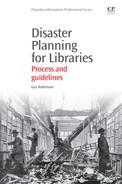0%
30Chapters
0-1Hours read
0kTotal Words
Book Description
Libraries are constantly at risk. Every day, many libraries and their collections are damaged by fire, flooding, high winds, power outages, and criminal behaviour. Every library needs a plan to protect its staff, sites and collections, including yours. Disaster Planning for Libraries provides a practical guide to developing a comprehensive plan for any library. Twelve chapters cover essential areas of plan development; these include an overview of the risks faced by libraries, disaster preparedness and responding to disasters, resuming operations after a disaster and assessing damage, declaring disaster and managing a crisis, cleaning up and management after a disaster and normalizing relations, staff training, testing disaster plans, and the in-house planning champion.- Provides a practical approach to developing a comprehensive plan for any library, big or small
- Supplements technical information with interviews and case studies
- Includes appendices covering pandemic management, moisture control, and library security
Book Description
Libraries are constantly at risk. Every day, many libraries and their collections are damaged by fire, flooding, high winds, power outages, and criminal behaviour. Every library needs a plan to protect its staff, sites and collections, including yours. Disaster Planning for Libraries provides a practical guide to developing a comprehensive plan for any library. Twelve chapters cover essential areas of plan development; these include an overview of the risks faced by libraries, disaster preparedness and responding to disasters, resuming operations after a disaster and assessing damage, declaring disaster and managing a crisis, cleaning up and management after a disaster and normalizing relations, staff training, testing disaster plans, and the in-house planning champion.- Provides a practical approach to developing a comprehensive plan for any library, big or small
- Supplements technical information with interviews and case studies
- Includes appendices covering pandemic management, moisture control, and library security
Table of Contents
- Cover
- Title page
- Table of Contents
- Copyright
- Dedication
- Acknowledgments
- Preface
- A note on terminology
- How to use this book
- About the author
- 1: Libraries and risk
- 2: Preparedness
- Abstract
- 2.1. Authorization
- 2.2. Committees: pros and cons
- 2.3. RAA, step one: history-taking
- 2.4. RAA, step two: inspection
- 2.5. RAA, step three: interviews
- 2.6. RAA, step four: discussions with external experts
- 2.7. RAA, step five: documentation
- 2.8. Mitigation: preventative maintenance programmes
- 2.9. Mitigation: gradual replacement of older facilities
- 2.10. Mitigation: insurance
- 2.11. Mitigation: data back-up
- 2.12. Mitigation: the key
- 2.13. References
- 3: Disaster response
- 4: Operational resumption, continuity and recovery
- 5: Damage assessment
- 6: Disaster recognition, declaration procedures and crisis management
- 7: Strategic alliances
- 8: Post-disaster management of patrons
- 9: Normalization of operations
- 10: Orientation and training programmes
- Abstract
- 10.1. Binder dependence
- 10.2. Definitions: orientation and training
- 10.3. Purposes of orientation and training
- 10.4. Assumptions
- 10.5. Methods of delivery
- 10.6. Home circulars
- 10.7. Newsletter/Intranet materials
- 10.8. Staff orientation sessions
- 10.9. Management orientation sessions
- 10.10. Operational resumption and continuity orientation and training
- 10.11. Management security seminars
- 10.12. Training the trainers
- 10.13. Session reporting
- 10.14. References
- 11: Basic tabletop exercises
- 12: Process and results
- Abstract
- 12.1. The overwhelming question
- 12.2. A case history: in the beginning
- 12.3. The process: preparedness
- 12.4. The process: response
- 12.5. The process: resumption
- 12.6. The process: backtracking
- 12.7. The process: orientation, training and testing
- 12.8. A real scenario
- 12.9. Use of the disaster plan
- 12.10. Post-resumption
- 12.11. References
- Further reading
- Appendix One: Lancaster Gate Public Library Crisis Management Plan
- Appendix Two: Pandemic Management Program
- Appendix Three: Main Library and Branch Post-Disaster Security Plan
- Appendix Four: Lancaster Gate Public Library
- Appendix Five: Main Library and Branch Post-Disaster Staff Allocation Plan
- Appendix Six: Information Technology Disaster Recovery Plan
- Index
